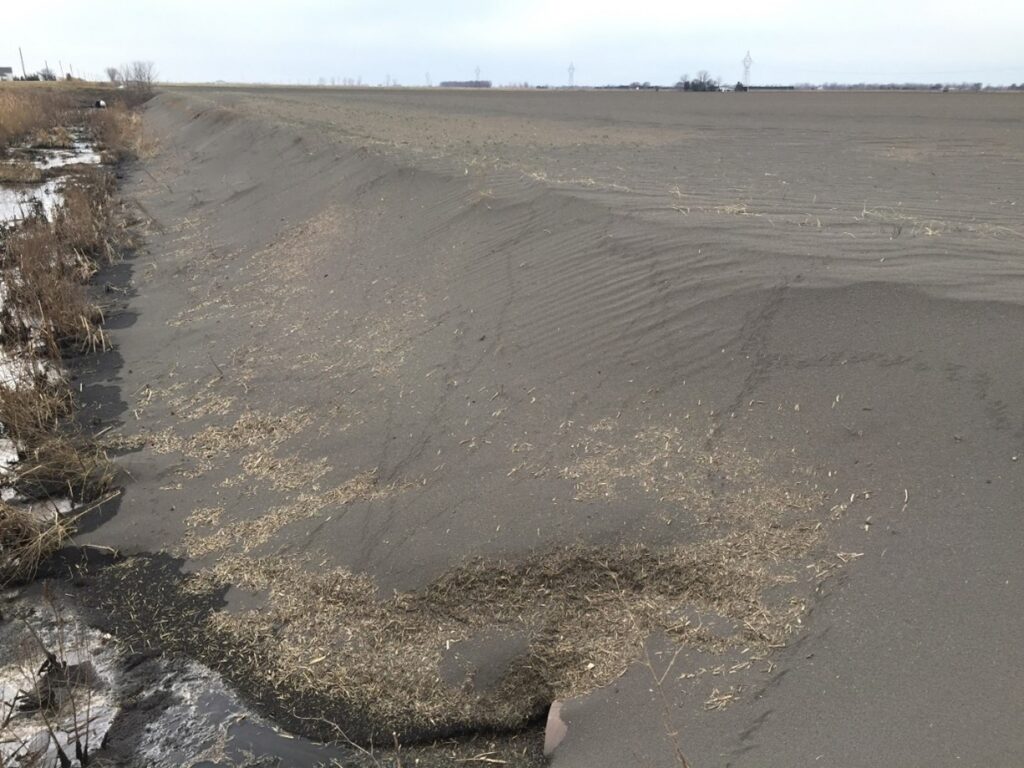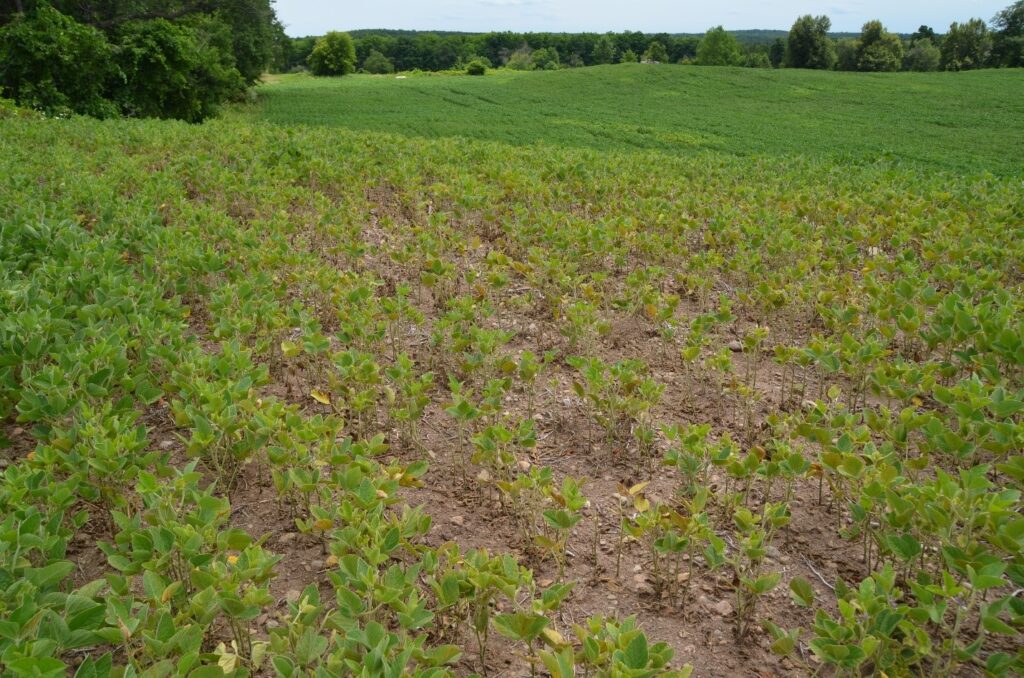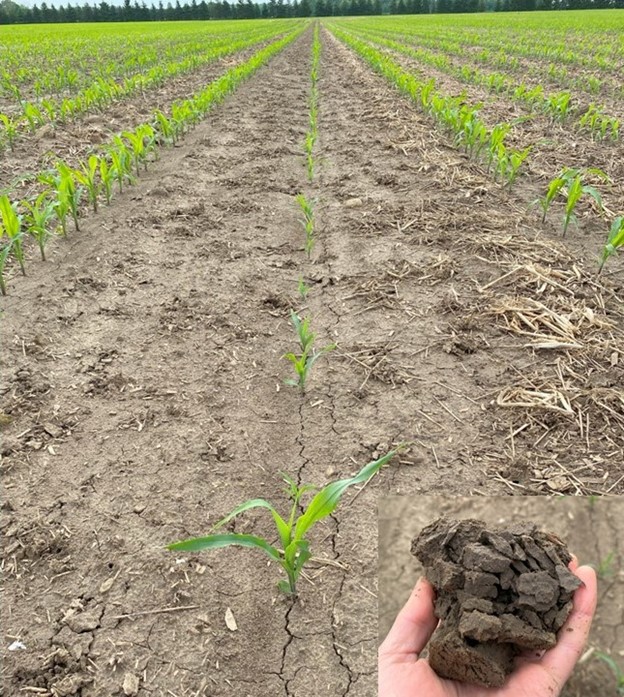Ontario agriculture has changed drastically since the mid-20th century and even more in recent decades. Fields are much larger, crop and livestock production are more specialized, a smaller percentage of crops grown are perennial, and equipment is more sophisticated and larger than ever before. While modern crop production practices have brought gains in efficiency and in some cases (e.g., no-till planting) improvements in soil conservation, others, like heavier equipment and frequently-grown soybeans, have increased the threat of soil degradation.
Soil degradation is the process by which the physical, biological, and/or chemical health of a soil is decreased. Degraded soils do not effectively perform the critical functions that support healthy crop growth. In Ontario, two primary drivers of soil degradation are erosion and compaction. An overview of each is provided below.
Erosion
Soil erosion is the physical movement of soil by water, wind, or tillage. Although it is a naturally occurring process, it occurs at an accelerated rate on agricultural land and is a major degradation risk in Ontario.
All types of soil erosion include three phases: soil detachment, movement, and deposition. Topsoil can be relocated elsewhere in the field (e.g., into a depression) or carried off the field entirely, for example into the ditch bank or neighbouring field. Either way, by moving topsoil, erosion reduces organic matter and soil fertility levels and reduces productivity.
Water erosion
Water erosion happens when soil particles are detached by water and moved downslope by rain impact or runoff. Risk factors include rainfall (e.g., intensity and amount of precipitation), soil erodibility (soil texture, organic matter, and structure), slope gradient and length, cropping and vegetation (e.g., annuals or perennials, amount of residue), and tillage practices (depth, direction, timing, and number of passes).
There are three main types of in-field water erosion:
- Sheet erosion occurs when water flows more or less evenly over the surface. While the quantity of soil particles lost can be substantial, it is usually difficult to notice visually.
- Rill erosion takes place when runoff begins to concentrate. Rills appear as shallow, typically parallel gouges on the slope (Figure 1).
- Gully erosion occurs when runoff quantity and concentration is higher than with rills and is often seen where rills and/or slopes converge. A gully is ephemeral if it is small enough to be masked by tillage. When larger, a gully is considered permanent.

Figure 1. Rill erosion in a cropped field.
Wind Erosion
Wind erosion occurs most often on light-textured and muck soils and on flat fields with minimal residue cover that are exposed to prevailing winds. Other risk factors include smoothly cultivated soils, dry conditions, high wind velocity and turbulence, and long distances between wind obstacles.
Soil particles are eroded by wind in three ways, depending on soil particle size and wind strength:
- Suspension is the movement of dust-sized particles (i.e., very fine sands and silt) in the air.
- Saltation is a series of short bounces along the soil surface and occurs with sand particles and very fine aggregates.
- Surface creep is rolling or sliding of larger soil particles such as medium and coarse sands.
Wind erosion can damage crops by sandblasting and degrades soil quality and fertility by blowing topsoil off the field. Figure 2 shows the impact of wind erosion caused by an early spring windstorm before crop planting on a flat, low residue field in southwestern Ontario.

Figure 2. Wind-blown soil in a ditch (Photo: Lower Thames Valley Conservation Authority)
Tillage Erosion
Tillage erosion occurs when tillage re-distributes soil from high slope positions to lower slope positions. It is aided by gravity, which moves soil particles down-slope, and takes place gradually over many years. Tillage erosion moves topsoil off the very tops of knolls, where it is then more susceptible to water erosion. This form of erosion is especially common on fields with complex topography.
The magnitude of tillage erosion is influenced by the type of tillage equipment, direction of tillage, speed and depth of tillage, and number of tillage passes. Tillage equipment that lifts and carries soil, operates up and down slope, moves at fast speeds and at depth, and performs multiple passes tends to cause more erosion. Figure 3 shows the negative impact of tillage erosion over time on crop productivity.

Figure 3. Soybeans growing poorly on a knoll affected by tillage erosion.
Compaction
Compaction occurs when soil particles are forced closer together by the impact of an applied force such as equipment traffic, tillage implements, animals, or even rainfall. It results in increased bulk density and a reduction in soil pore space, which in turn reduces root exploration, drainage, and air exchange. The trend toward larger equipment and higher axle loads, particularly when combined with compressed periods for field activities of larger farm operations in the spring and fall, has increased soil compaction risk on Ontario farms.
All soil types are susceptible to compaction, though those with a higher clay content and poor drainage are more vulnerable and for greater periods of the year. Soils with depleted organic matter due to simple crop rotations and excessive tillage are most likely to be compacted as they are poorly aggregated and have lower soil strength.
Not all soil compaction is the same. Surface compaction occurs in the top 6-8 inches and is often caused by frequent tillage and equipment traffic, especially under unfit soil conditions. Rainfall can also cause a type of surface compaction, called crusting, in poorly structured soils by breaking up aggregates and allowing clay and silt to settle and form a seal. Subsoil compaction occurs below the top 6-8 inches, where soil is more vulnerable because it’s often wetter, higher in clay content, and lower in organic matter. Heavy equipment loads are the main driver of subsoil compaction. Deep subsoil compaction cannot be ameliorated by natural weather cycles or tillage (Dejong-Hughes & Daigh, 2022).
Compaction can lower stands, delay crop development, and result in shorter plants with smaller roots systems (Figure 4). Nutrient uptake is reduced in compacted fields, while the risk of nitrogen loss by denitrification is increased. Research has found crop yield impacts as high as 60% (Dejong-Hughes & Daigh, 2021), but effects are often variable depending on soil type, crop, and weather conditions. Yield reductions can last for years; after initial impacts, they tend to show up most under seasons of drought or excessive precipitation.

Figure 4. Reduced stand and corn stunting due to compaction from manure application in an Ontario field. Blocky, low-pore space soil from the corn row (inset).
There are many practices that can limit compaction risk. They include performing timely field operations, growing perennials or fibrous-rooted crops such as cereals, reducing axle loads, lowering tire pressures, and adopting newer tire technologies to improve load distribution.
Learn more
Best management practices that combine tried-and-true techniques with new technologies are being used by many Ontario farmers to counter soil degradation risks. Management options to address soil degradation concerns, including residue management, reduced tillage, crop rotation and cover crops, are covered in separate factsheets.
For more detailed information on soil erosion, download OMAFA factsheet #24-019: Soil Erosion – Causes and Effects.
References
DeJong-Hughes, J. and Daigh, A. 2021. Upper Midwest Tillage Guide. University Digital Conservancy. https://hdl.handle.net/11299/263302.
Hayes, A. et al. Best Management Practices: Wind Erosion. OMAFRA Factsheet. https://bmpbooks.com/publications/wind-erosion/
Magdoff, F. and Van Es, H. 2021. Building Soils for Better Crops, Fourth Edition. Sustainable Agriculture Research & Education (SARE). https://www.sare.org/resources/building-soils-for-better-crops/
McKague, K. 2024. Soil erosion: causes and effects. OMAFA Factsheet #24-019. https://www.ontario.ca/page/soil-erosion-causes-and-effects.